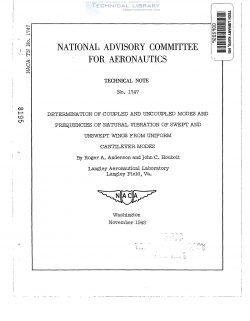naca-tn-1747
- Version
- 115 Downloads
- 1.43 MB File Size
- 1 File Count
- December 6, 2016 Create Date
- December 6, 2016 Last Updated
National Advisory Committee for Aeronautics, Technical Notes - Determination of Coupled and Uncoupled Modes and Frequencies of Natural Vibration of Swept and Unswept Wings from Uniform Cantilever Modes

A solution is presented for the coupled and uncoupled. modes and
frequencies of wings (swept or unswept) mounted on a fuselage. The
deflection and twist of the wing is expanded in terms of the modes of a
uniform cantilever beam and the energy method is used to derive the
characteristic equations describing symmetrical and antisymmetrical
modes of vibrations. Application of these equations to various types of
wing vibration is illustrated by numerical examples. The numerical
examples chosen were susceptible to exact solution, and the results show
that accurate modes and frequencies can be obtained by a method in which
low-order determinants are used.
Except for certain idealized cases, the natural vibration modes and
frequencies of airplane wings (swept or unswept) cannot be found by
exact analysis, and thus approximate methods of solution must be used.
Such a solution is presented for the general problem of coupled bending
and torsional vibration of a nonuniform wing mounted at an angle of
sweep on a fuselage. The energy method is used to derive two sets of
linear characteristic equations, one for symmetrical modes and the other
for antisymmetrical modes. These same equations also .lead to solutions
for the coupled and uncoupled modes and frequencies of the unswept wing
and fuselage. The equations are solved by the Grout method which per-
mits independent calculation of any desired mode and frequency.
In this solution the deflection and twist of the wings are assumed
to conform to elementary beam theory. Such an assumption may or may not
lead to an analysis which is applicable to wings having low aspect
ratio, especially when appreciable sweep is present, because the effects
of the distortions in the vicinity of the root of the wings are not
fully understood. The present analysis considers the fuselage to be a
rigid body, but the analysis may be extended to treat an elastic
fuselage.
| File | Action |
|---|---|
| naca-tn-1747 Determination of Coupled and Uncoupled Modes and Frequencies of Natural Vibration of Swept and Unswept Wings from.pdf | Download |

Comment On This Post